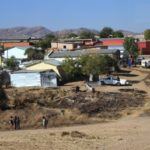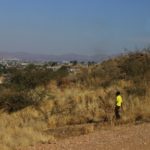Driving through Windhoek, the capital city of Namibia, one can see a huge contrast in living. At one point, one can see average houses that have garages, fences, multiple stories, and nice vehicles. As one continues, “squatter settlements” appear, where houses are made of tin, small, and are crammed together. The wealth distribution gap in Namibia is immense.
As we drove through the squatter settlements we saw the small tin houses with people going on about their daily chores. Other sights in town included stray dogs, women walking with baskets on their heads and buckets in their arms, and young children walking unaccompanied. There were bars in almost every other tin shack; I could guess this might be related to numerous billboards advertising alcohol. We also saw cellphone repair and a plethora of hair salons in these tiny tin shacks.
As we continued driving, we spotted many identical, numbered houses that were built by the Germans before Namibian independence to place all Africans in a centralized area. These houses had fences, windows, and some even had BMWs in the driveway.
The drastic range of living accommodations in Windhoek is shocking. How can these vastly different living situations be located in the same city, not but a few minutes from each other? Actually, the living situations may not be so shocking. Similarly, as one drives through Houston, they see large and prestigious mansions followed by rows of homes that cannot compare. I realize that this “pocketing” is a misfortune for Namibia and the United States.
We must realize that although every country has defining features, there are similarities. We cannot only focus on the differences. Although the United States may not have the amount of poverty that Namibia does, there is poverty everywhere and wealth distribution gaps are visible no matter what country. Despite the vast differences of Namibia and the United States, we may not be so different after all.


Leave a Reply